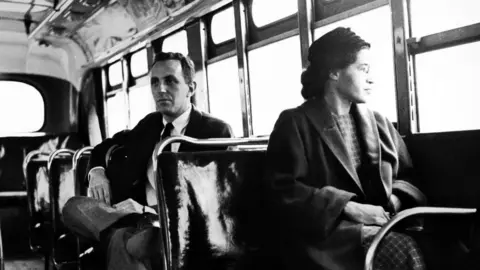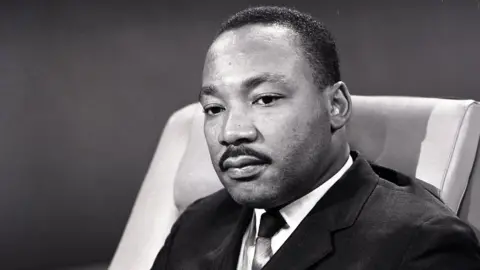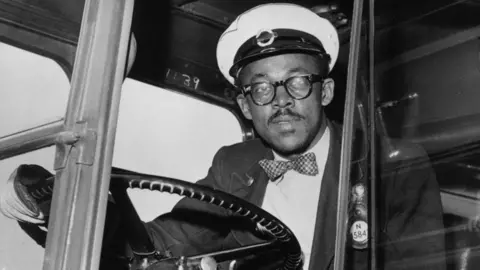Claudette Colvin: The 15-year-old who came before Rosa Parks
 Alamy
AlamyIn March 1955, nine months before Rosa Parks defied segregation laws by refusing to give up her seat to a white passenger on a bus in Montgomery, Alabama, 15-year-old Claudette Colvin did exactly the same thing. Eclipsed by Parks, her act of defiance was largely ignored for many years. She herself didn't talk about it much, but she spoke recently to the BBC.
"There was segregation everywhere. The churches, buses and schools were all segregated and you couldn't even go into the same restaurants," Claudette Colvin says.
"I remember during Easter one year, I was to get a pair of black patent shoes but you could only get them from the white stores, so my mother drew the outline of my feet on a brown paper bag in order to get the closest size, because we weren't allowed to go in the store to try them on."
Going to a segregated school had one advantage, she found - her teachers gave her a good grounding in black history.
"We learned about negro spirituals and recited poems but my social studies teachers went into more detail," she says.
 Getty Images
Getty Images"They lectured us about Harriet Tubman and Sojourner Truth and we were taught about an opera singer called Marian Anderson who wasn't allowed to sing at Constitutional Hall just because she was black, so she sang at Lincoln Memorial instead."

Tubman and Truth
- Harriet Tubman and Sojourner Truth were both African Americans who sought the abolition of slavery
- Tubman was well known for helping 300 fellow slaves escape slavery using the Underground Railroad
- Truth was a passionate campaigner who fought for women's rights, best known for her speech Ain't I a Woman?

On 2 March 1955, Colvin and her friends finished their classes and were let out of school early.
"We walked downtown and my friends and I saw the bus and decided to get on, it was right across the road from Dr Martin Luther King's church," Colvin says.
"The white people were always seated at the front of the bus and the black people were seated at the back of the bus. The bus driver had the authority to assign the seats, so when more white passengers got on the bus, he asked for the seats."
The problem arose because all the seats on the bus were taken. Colvin and her friends were sitting in a row a little more than half way down the bus - two were on the right side of the bus and two on the left - and a white passenger was standing in the aisle between them.
The driver wanted all of them to move to the back and stand so that the white passenger could sit.
"He wanted me to give up my seat for a white person and I would have done it for an elderly person but this was a young white woman. Three of the students had got up reluctantly and I remained sitting next to the window," she says.
 Getty Images
Getty ImagesUnder the twisted logic of segregation the white woman still couldn't sit down, as then white and black passengers would have been sharing a row of seats - and the whole point was that white passengers were meant to be closer to the front.
But Colvin told the driver she had paid her fare and that it was her constitutional right to remain where she was.
"Whenever people ask me: 'Why didn't you get up when the bus driver asked you?' I say it felt as though Harriet Tubman's hands were pushing me down on one shoulder and Sojourner Truth's hands were pushing me down on the other shoulder. I felt inspired by these women because my teacher taught us about them in so much detail," she says.
"I wasn't frightened but disappointed and angry because I knew I was sitting in the right seat."
The driver kept on going but stopped when he reached a junction where a police squad car was waiting. Two policemen boarded the bus and asked Colvin why she wouldn't give up her seat.
"I was more defiant and then they knocked my books out of my lap and one of them grabbed my arm. I don't know how I got off that bus but the other students said they manhandled me off the bus and put me in the squad car. But what I do remember is when they asked me to stick my arms out the window and that's when they handcuffed me," Colvin says.
Instead of being taken to a juvenile detention centre, Colvin was taken to an adult jail and put in a small cell with nothing in it but a broken sink and a cot without a mattress.
"I was scared and it was really, really frightening, it was like those Western movies where they put the bandit in the jail cell and you could hear the keys. I can still vividly hear the click of those keys.
"I waited for about three hours until my mother arrived with my pastor to bail me out. My mother knew I was disappointed with the system and all the injustice we were receiving and she said to me: 'Well, Claudette, you finally did it.'"
After Colvin was released from prison, there were fears that her home would be attacked. Members of the community acted as lookouts, while Colvin's father sat up all night with a shotgun, in case the Ku Klux Klan turned up.

Find out more
- Claudette Colvin spoke to Outlook on the BBC World Service
- You can listen again here

Colvin was the first person to be arrested for challenging Montgomery's bus segregation policies, so her story made a few local papers - but nine months later, the same act of defiance by Rosa Parks was reported all over the world.
Like Colvin, Parks was commuting home and was seated in the "coloured section" of the bus. When the white seats were filled, the driver, J Fred Black, asked Parks and three others to give up their seats. Like Colvin, Parks refused, and was arrested and fined.
 Alamy
AlamyAt the time, Parks was a seamstress in a local department store but was also a secretary of the Montgomery chapter of the National Association for the Advancement of Coloured People (NAACP).
Colvin knew her very well.
"I became very active in her youth group and we use to meet every Sunday afternoon at the Luther church," she says.
"Ms Parks was quiet and very gentle and very soft-spoken, but she would always say we should fight for our freedom."
Colvin says Parks had the right image to become the face of resistance to segregation because of her previous work with the NAACP. The organisation didn't want a teenager in the role, she says.
Another factor was that before long Colvin became pregnant.
"They said they didn't want to use a pregnant teenager because it would be controversial and the people would talk about the pregnancy more than the boycott," Colvin says.
On the night of Parks' arrest, the Women's Political Council (WPC), a group of black women working for civil rights, began circulating flyers calling for a boycott of the bus system. Soon afterwards, on 5 December, 40,000 African-American bus passengers boycotted the system and that afternoon, black leaders met to form the Montgomery Improvement Association (MIA), electing a young pastor, Martin Luther King Jr, as their president.

The boycott was very effective but the city still resisted complying with protesters' demands - an end to the policy preventing the hiring of black bus drivers and the introduction of first-come first-seated rule. To sustain the boycott, communities organised carpools and the Montgomery's African-American taxi drivers charged only 10 cents - the same price as bus fare - for fellow African Americans.
A year later, on 20 December 1956, the US Supreme Court ruled that segregation on the buses must end. The legal case turned on the testimony of four plaintiffs, one of whom was Claudette Colvin.
"The NAACP had come back to me and my mother said: 'Claudette, they must really need you, because they rejected you because you had a child out of wedlock,'" Colvin says.
"So I went and I testified about the system and I was saying that the system treated us unfairly and I used some of the language that they used when we got taken off the bus."
Colvin says that after Supreme Court made its decision, things slowly began to change. However, some white passengers still refused to sit near a black person.
 NICOLE BENGIVENO / New York Times
NICOLE BENGIVENO / New York TimesWhen Colvin moved to New York many years later to become a nurse, she didn't tell many people about the part she played in the civil rights movement.
"New York is a completely different culture to Montgomery, Alabama. Most of the people didn't have problems with us sitting on the bus, most New Yorkers cared about economic problems. I didn't want to discuss it with them," she says.
In 2009, the writer Phillip Hoose published a book that told her story in detail for the first time.
"He said he wanted the people to know about the 15-year-old, because really, if I had not made the first cry for freedom, there wouldn't have been a Rosa Parks, and after Rosa Parks, there wouldn't have been a Dr King.
"And I lived to see that change."

More from the BBC
 Central Press
Central PressFifty years have passed since campaigners overturned a ban on ethnic minorities working on buses in one British city. Today their boycott, modelled on the one in Montgomery, is largely forgotten - but it was a milestone in achieving equality.

